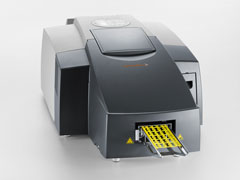Jun 3 2008
When it comes to producing large molded parts with thick walls and changes in wall thickness, injection molding using solid plastics is often stretched to its limits. Problems include sink marks, warpage, shrinkage and poor dimensional stability. Although designers can prevent sink marks by using reinforcing ribs, this approach complicates the geometry of the components, which leads to high mold costs. An alternative, cost-effective process that can be used in such cases is structural foam molding of thermoplastics with blowing agents, or TSG. This process produces molded parts with a foam structure on the inside and a smooth, solid surface on the outside, and offers clear advantages – as can be seen in the housing components for the PrintJet PRO industrial inkjet printer.
 Three large housing components for an industrial inkjet printer are manufactured from Makrolon® SF800Z using the TSG process. The polycarbonate exhibits outstanding flame retardance.
Three large housing components for an industrial inkjet printer are manufactured from Makrolon® SF800Z using the TSG process. The polycarbonate exhibits outstanding flame retardance.
The printer, developed by Weidmüller Interface GmbH & Co. KG, based in Detmold, Germany, has been designed to print on special plastic markers for a whole range of components used in electrical connection systems. It is currently the only inkjet printing system available for this type of application that produces extremely detailed color graphics while also offering a robust, industrial design and high print speeds.
Coko-Werk GmbH & Co. KG, based in Bad Salzuflen, Germany, is responsible for manufacturing the housing components for the printer. The company uses the polycarbonate Makrolon® SF800Z from Bayer MaterialScience AG, which has been customized for the TSG process.
The inkjet printer measures 1,060 x 500 x 310 millimeters (length x width x height). Its housing is made up of three large sections, the wall thicknesses of which vary between 3.5 and 6.5 millimeters and involve sizeable geometric stepping. It was therefore decided early on that the lightweight parts with their complex geometrical shapes would be manufactured cost effectively using the TSG process, which would also enable the use of inexpensive aluminum molds. The manufacturers considered several materials before opting for Makrolon® SF800Z due to the various benefits it offers. For example, it is stiff and tough and offers far greater dimensional stability than glass fiber-reinforced polyamide. This enables the manufacturers to precisely position anchoring elements for the housing components, which is essential to ensure that print results are accurate and are not adversely affected by vibrations in the housing. “Our material is also more heat resistant than glass fiber-reinforced polystyrene, polypropylene and ABS. It is therefore able to cope with the temperatures of up to 120 °C that are generated by the integral fixing unit inside the printer during continuous use,” explains Harry Staratschek, Technical Account Manager for Weidmüller in the Polycarbonates Business Unit. The polycarbonate also produces top-quality surfaces that no longer need to be roughened prior to application of a textured coating, and also ensure extremely good adhesion.
In principle, the housing components could also have been manufactured with a thermoset plastic. However, the parts are more cost effective to produce, lighter in weight, less prone to distortion and have a better quality surface when made from Makrolon® SF800Z. What’s more, thermoplastics are also easier to recycle.
Weidmüller also made excellent flame retardance a key requirement for the housing, as thermoplastic structural foams tend to perform less well than similar solid thermoplastics in terms of their fire behavior. Bayer MaterialScience therefore carried out extensive fire testing on samples made from various densities of foam. The results showed that Makrolon® SF800Z exhibits outstanding flame retardance in its foamed state. It now has a Yellow Card listing from the U.S. testing organization UL (Underwriters Laboratories) with the excellent classification V-0 for test pieces three millimeters thick and 5VA for test pieces five millimeters thick (minimum density 0.73 g/cm3). “As a result, our TSG material is well in tune with the trend towards the use of plastic parts with better flame retardance in electrical and electronic applications,” explains Staratschek. The bromine-, chlorine- and antimony-free polycarbonate also offers outstanding eco-friendly credentials, and satisfies the requirements of EU legislation in the form of the WEEE (Waste Electrical and Electronic Equipment) and RoHS (Restriction of the Use of Hazardous Substances in Electrical and Electronic Equipment) guidelines.